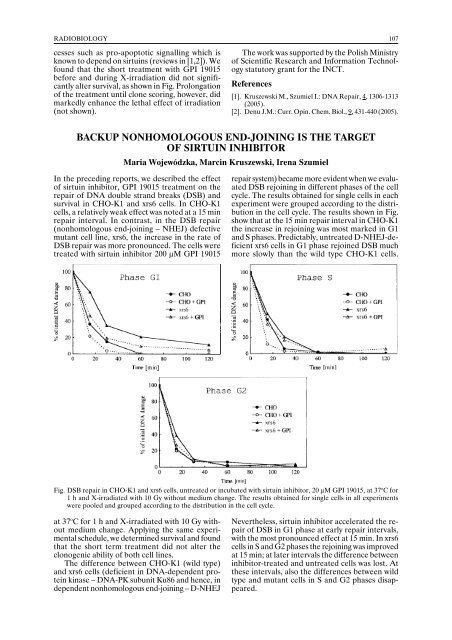annual report annual report annual report annual report 2005
annual report annual report annual report annual report 2005
annual report annual report annual report annual report 2005
Create successful ePaper yourself
Turn your PDF publications into a flip-book with our unique Google optimized e-Paper software.
RADIOBIOLOGY 107<br />
cesses such as pro-apoptotic signalling which is<br />
known to depend on sirtuins (reviews in [1,2]). We<br />
found that the short treatment with GPI 19015<br />
before and during X-irradiation did not significantly<br />
alter survival, as shown in Fig. Prolongation<br />
of the treatment until clone scoring, however, did<br />
markedly enhance the lethal effect of irradiation<br />
(not shown).<br />
The work was supported by the Polish Ministry<br />
of Scientific Research and Information Technology<br />
statutory grant for the INCT.<br />
References<br />
[1]. Kruszewski M., Szumiel I.: DNA Repair, 4, 1306-1313<br />
(<strong>2005</strong>).<br />
[2]. Denu J.M.: Curr. Opin. Chem. Biol., 9, 431-440 (<strong>2005</strong>).<br />
BACKUP NONHOMOLOGOUS END-JOINING IS THE TARGET<br />
OF SIRTUIN INHIBITOR<br />
Maria Wojewódzka, Marcin Kruszewski, Irena Szumiel<br />
In the preceding <strong>report</strong>s, we described the effect<br />
of sirtuin inhibitor, GPI 19015 treatment on the<br />
repair of DNA double strand breaks (DSB) and<br />
survival in CHO-K1 and xrs6 cells. In CHO-K1<br />
cells, a relatively weak effect was noted at a 15 min<br />
repair interval. In contrast, in the DSB repair<br />
(nonhomologous end-joining – NHEJ) defective<br />
mutant cell line, xrs6, the increase in the rate of<br />
DSB repair was more pronounced. The cells were<br />
treated with sirtuin inhibitor 200 µM GPI 19015<br />
repair system) became more evident when we evaluated<br />
DSB rejoining in different phases of the cell<br />
cycle. The results obtained for single cells in each<br />
experiment were grouped according to the distribution<br />
in the cell cycle. The results shown in Fig.<br />
show that at the 15 min repair interval in CHO-K1<br />
the increase in rejoining was most marked in G1<br />
and S phases. Predictably, untreated D-NHEJ-deficient<br />
xrs6 cells in G1 phase rejoined DSB much<br />
more slowly than the wild type CHO-K1 cells.<br />
Fig. DSB repair in CHO-K1 and xrs6 cells, untreated or incubated with sirtuin inhibitor, 20 µM GPI 19015, at 37 o C for<br />
1 h and X-irradiated with 10 Gy without medium change. The results obtained for single cells in all experiments<br />
were pooled and grouped according to the distribution in the cell cycle.<br />
at 37 o C for 1 h and X-irradiated with 10 Gy without<br />
medium change. Applying the same experimental<br />
schedule, we determined survival and found<br />
that the short term treatment did not alter the<br />
clonogenic ability of both cell lines.<br />
The difference between CHO-K1 (wild type)<br />
and xrs6 cells (deficient in DNA-dependent protein<br />
kinase – DNA-PK subunit Ku86 and hence, in<br />
dependent nonhomologous end-joining – D-NHEJ<br />
Nevertheless, sirtuin inhibitor accelerated the repair<br />
of DSB in G1 phase at early repair intervals,<br />
with the most pronounced effect at 15 min. In xrs6<br />
cells in S and G2 phases the rejoining was improved<br />
at 15 min; at later intervals the difference between<br />
inhibitor-treated and untreated cells was lost. At<br />
these intervals, also the differences between wild<br />
type and mutant cells in S and G2 phases disappeared.
















